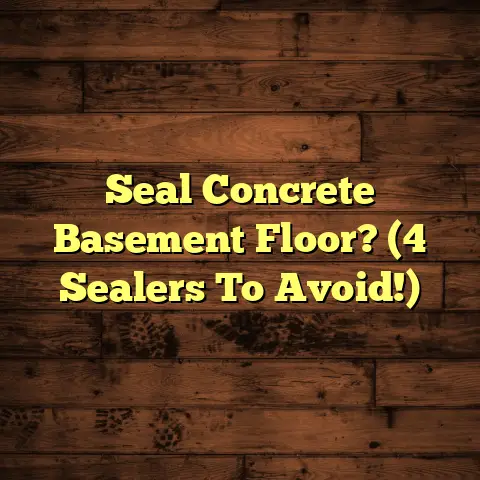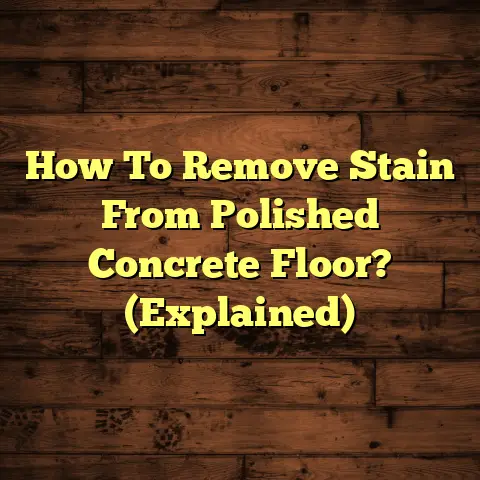Best Pet-Proof Laminate? (2 Must-Have Features!)
And these days, more and more homeowners are looking for eco-friendly options. I totally get it. We want our homes to look great, be functional and tread lightly on the planet.
That’s where pet-proof laminate comes in. It’s a fantastic way to merge durability with sustainability. But not all laminates are created equal, especially when it comes to furry friends.
Choosing the right laminate isn’t just about aesthetics. It’s about finding something that can withstand the daily wear and tear from your pets while aligning with your eco-conscious values.
So, what are the absolute must-have features? Let’s dive in!
Section 1: Understanding Pet-Proof Laminate Flooring
Okay, so what is laminate flooring anyway?
Essentially, it’s a multi-layered synthetic flooring product fused together through a lamination process. Think of it like a super-durable photograph of wood (or stone, or tile!).
Typically, you’ll find these layers:
-
Wear Layer: This is the top, protective layer. It’s what determines the laminate’s resistance to scratches, stains, and fading.
-
Decorative Layer: This is the high-resolution image that gives the laminate its realistic look.
-
Core Board: This is the main structural component, usually made of high-density fiberboard (HDF) or medium-density fiberboard (MDF). It provides stability and impact resistance.
-
Backing Layer: This bottom layer provides a moisture barrier and helps to balance the floor.
Now, let’s talk pets. As much as we love them, they can be tough on floors. Scratches from claws, stains from accidents, and lingering odors are all common issues.
That’s where pet-proof laminate shines. It’s designed with enhanced features to combat these problems. But what’s the difference between standard and pet-proof laminate?
Well, pet-proof laminate typically has a thicker, more durable wear layer for superior scratch resistance. It also often incorporates water-resistant or waterproof technology to prevent moisture damage from spills and accidents.
Think of it as the difference between a regular t-shirt and one designed for intense workouts – both are shirts, but one is built to handle a lot more!
Compared to other flooring options like hardwood or carpet, laminate offers some significant advantages for pet owners. Hardwood can be easily scratched and damaged by moisture, while carpets can trap odors and stains.
Laminate, on the other hand, is generally more scratch-resistant, easier to clean, and less likely to harbor odors. Plus, it’s often more affordable than hardwood, making it a budget-friendly option.
Here’s a quick comparison:
| Feature | Hardwood | Carpet | Laminate |
|---|---|---|---|
| Scratch Resistance | Low | Medium (but hides scratches well) | High (especially pet-proof) |
| Stain Resistance | Low | Low | Medium to High |
| Water Resistance | Low | Low | Medium to High (depending on type) |
| Odor Resistance | Low | Low | Medium to High |
| Cost | High | Medium | Medium |
| Maintenance | Requires specialized cleaning & refinishing | Requires frequent vacuuming & professional cleaning | Easy to clean with regular sweeping & mopping |
Section 2: Must-Have Feature #1 – Scratch Resistance
Let’s get down to brass tacks. The first, and arguably most important, feature for pet-proof laminate is scratch resistance. I can’t stress this enough!
If you have dogs or cats with even moderately active claws, this is a non-negotiable. I’ve seen beautiful floors ruined in a matter of months by enthusiastic pets.
The secret to scratch-resistant laminate lies in its wear layer. This top layer is typically made of aluminum oxide, a super hard material that resists abrasion. The thicker the wear layer, the better the scratch resistance.
Wear layers are measured in mils (thousandths of an inch). For pet-proof laminate, I generally recommend looking for a wear layer of at least 12 mils, but 20 mils or higher is even better.
Some brands even use enhanced wear layer technology, like diamond-infused coatings, to provide even greater protection. I’ve personally installed floors with these coatings and have been amazed by their durability.
So, which brands stand out in the scratch resistance department?
While I can’t endorse specific brands (and formulations change frequently), I can say that some manufacturers are consistently praised for their durable wear layers. Look for brands that specifically market their products as “pet-friendly” or “scratch-resistant.”
Do your research, read reviews, and ask your flooring contractor for recommendations.
Speaking of research, it’s worth noting that some eco-friendly laminates also offer excellent scratch resistance. For example, some manufacturers use recycled materials in their core boards and low-VOC finishes, while still maintaining a high level of durability.
This is a win-win – you get a floor that can withstand your pets and is also better for the environment.
I’ve talked to many pet owners who have made the switch to scratch-resistant laminate, and the feedback is overwhelmingly positive.
One client, Sarah, told me that her previous hardwood floors were constantly covered in scratches from her two golden retrievers. After installing scratch-resistant laminate, she said she could finally relax and enjoy her dogs without worrying about the floors.
“It’s been a game-changer,” she said. “I can’t believe how well it’s held up. And the best part is, it looks great too!”
Now, even the most scratch-resistant laminate isn’t completely indestructible. That’s why proper maintenance is key. Here are a few tips for keeping your laminate floors looking new:
-
Sweep or vacuum regularly: This removes dirt and debris that can scratch the floor.
-
Use a damp mop with a pH-neutral cleaner: Avoid harsh chemicals or abrasive cleaners, as these can damage the wear layer. I always recommend looking for eco-friendly cleaning solutions.
-
Place mats at entrances: This helps to trap dirt and moisture before they get onto the floor.
-
Trim your pet’s nails regularly: This is the most effective way to prevent scratches.
-
Use furniture pads: Place pads under furniture legs to prevent scratches and dents.
By following these simple tips, you can keep your scratch-resistant laminate looking beautiful for years to come.
Section 3: Must-Have Feature #2 – Water Resistance
Okay, we’ve covered scratches. Now, let’s talk about another major challenge for pet owners: water resistance.
Accidents happen. Spills happen. Sometimes, your furry friend might not make it outside in time. That’s why water resistance is absolutely crucial for pet-proof laminate.
Without it, you risk water damage, swelling, and even mold growth. Trust me, I’ve seen the aftermath, and it’s not pretty (or cheap to fix).
Laminate flooring comes in varying degrees of water resistance. Some are simply water-resistant, meaning they can withstand spills for a short period of time if cleaned up promptly. Others are waterproof, meaning they can handle prolonged exposure to water without damage.
For pet owners, I strongly recommend opting for waterproof laminate. It provides the best protection against accidents and spills.
The key to water resistance lies in the construction of the laminate. Waterproof laminates typically have a tightly sealed surface and a waterproof core. The seams between planks are also often sealed to prevent water penetration.
Some manufacturers use advanced technologies, like hydrophobic coatings, to repel water and prevent it from seeping into the floor. These coatings can make a huge difference in the long-term performance of the laminate.
Again, while I can’t recommend specific brands, I can say that some manufacturers consistently receive high marks for their water-resistant laminates. Look for products that are specifically labeled as “waterproof” or “water-resistant” and read reviews from other pet owners.
Don’t be afraid to ask your flooring contractor for their recommendations. They can often provide valuable insights based on their experience.
When choosing a water-resistant laminate, it’s also important to consider its eco-friendly attributes. Some manufacturers use recycled materials in their core boards and low-VOC adhesives, making their products more sustainable.
Look for certifications like FloorScore or GreenGuard, which indicate that the laminate has been tested for low chemical emissions.
I remember one client, Mark, who had a terrible experience with his previous laminate floor. His dog had an accident while he was at work, and by the time he got home, the floor had already started to swell and buckle.
He ended up having to replace the entire floor. After that experience, he was determined to find a truly waterproof option.
He eventually chose a laminate with a waterproof core and sealed seams. He told me that he’s had several accidents since then, but the floor has held up perfectly.
“It’s been a lifesaver,” he said. “I can finally relax knowing that my floors are protected.”
To preserve the water-resistant properties of your laminate flooring, it’s important to follow these maintenance tips:
-
Clean up spills immediately: The longer water sits on the floor, the greater the risk of damage.
-
Use a damp mop, not a wet mop: Avoid soaking the floor with water.
-
Avoid using steam cleaners: Steam can penetrate the seams and damage the core board.
-
Use mats in high-moisture areas: Place mats near doorways, sinks, and pet bowls to protect the floor from spills and splashes.
By following these tips, you can ensure that your water-resistant laminate flooring stays in great condition for years to come.
Section 4: Additional Considerations for Eco-Conscious Pet Owners
While scratch and water resistance are the two must-have features for pet-proof laminate, there are other factors that eco-conscious pet owners should consider.
One important aspect is low VOC emissions. VOCs (volatile organic compounds) are chemicals that can be released from building materials and affect indoor air quality.
Look for laminates that are certified as low-VOC or VOC-free. This will help to create a healthier living environment for you and your pets.
Another consideration is sustainable sourcing. Choose laminates that are made from responsibly harvested wood or recycled materials.
Look for certifications like the Forest Stewardship Council (FSC), which indicates that the wood used in the laminate comes from sustainably managed forests.
Some manufacturers also use recycled content in their core boards, which helps to reduce waste and conserve resources.
Finally, consider the life cycle impact of the laminate. This includes the energy and resources used to manufacture, transport, and dispose of the product.
Laminates with longer lifespans and lower maintenance requirements generally have a lower life cycle impact.
Compared to other flooring options, eco-friendly laminate can be a sustainable choice. It’s often more durable and easier to maintain than carpet, and it can be a more affordable and sustainable alternative to hardwood.
Here’s a quick comparison of eco-friendly laminate versus other flooring options:
| Flooring Type | Sustainability | Durability |
|---|---|---|
| Eco-Friendly Laminate | Made from recycled materials, low VOC emissions, sustainably sourced wood | High scratch and water resistance |
| Hardwood | Can be sustainable if FSC-certified, but requires more maintenance and can be easily damaged | Moderate durability, requires refinishing |
| Carpet | Often made from synthetic materials, can trap allergens and odors | Low durability, requires frequent cleaning and replacement |
| Tile | Durable and water-resistant, but can be energy-intensive to produce | High durability, but can be cold and hard |
Conclusion
So, there you have it! The two must-have features for pet-proof laminate are scratch resistance and water resistance. These features will help to protect your floors from the wear and tear of pets and keep them looking beautiful for years to come.
But don’t forget to consider other factors, like low VOC emissions, sustainable sourcing, and life cycle impact. By choosing an eco-friendly laminate, you can create a healthier and more sustainable home for you and your pets.
Choosing the right laminate flooring can truly enhance your living environment. It’s about creating a space that’s both functional and beautiful, while also being mindful of our planet.
So, take your time, do your research, and choose wisely. Your pets (and the planet) will thank you for it!
Ready to take the next step? Talk to your local flooring contractor about your options and find the perfect pet-proof, eco-friendly laminate for your home. Good luck!





